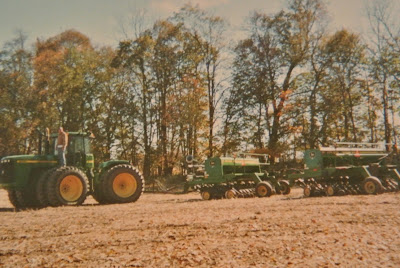
Is
this picture what you think of when you think of modern day farming? I was on Facebook and was so disappointed to
see this picture and the comment on it! In addition to the comment on the
picture the status update said “and we wonder why there is so much cancer and
why so many Americans are sick”. I
couldn’t believe what I was reading! So as an advocate for agriculture I’d like to
shed some light on the situation. I do
agree that every person is entitled to their opinion…this is mine and I hope it
helps you form an EDUCATED opinion backed by facts!
So
let’s start at the top of this picture.
Why is Monsanto being labeled in the first place? Do people even understand what Monsanto
does? Monsanto is committed to “producing
more, conserving more, and improving lives; that’s sustainable
agriculture”. In other words Monsanto
does lots of research to find better ways for the environment, consumer and
farmer to continue to thrive. But Monsanto isn’t the only company who does
this. There are many others
including: DuPont, Dow Agri Science, and
Syngenta just to name a few. The work these companies do is extremely important
for the world’s future generations.
The
world population is estimated to swell to 9 billion by 2050! As that many more people are coming into the
world, an increased amount of agricultural land is being lost to development. So therefore farmers have to push land harder
and harder to increase yields or else the world will go hungry. The only way to feed the world is by utilizing
science with agriculture which is done with the help of the companies listed
above.
The
next point on the picture talks about poisoning our food. I have to disagree.
Our
family farms conventionally; not organically. My family doesn’t poison your food and if you
say that I do take offense to it and give you some facts that show you
otherwise! I am not saying organic
farming is bad. I believe it is good for
people to have choices when consuming food.
That being said it is impossible to feed the world organically. It’s just not efficient enough.
At
the turn of the century it’s safe to say we were farming organically. We didn’t use any chemicals and no plants
were genetically modified. Science was
not yet integrated into agriculture. Yet
people died at a younger age. In 1900
the average expectancy for a man was only 46 years old, in 1950 it was 65 years
old, and in 2012 a man was expected to live to be 76 years old.
Why
did people die at a young age many years ago if we farmed without chemicals and
genetically modified plants? Many deaths
that long ago were of unknown origin. Could
those deaths have been cancer cases? Of
course some of those deaths in the early 1900’s could have been caused by cancer
that just went undiagnosed! Cancer is a
terrible thing that affects many families, but there aren’t any valid facts or
research that tie conventional farming practices with cancer. I hope with continued research cancer will be
a thing of the past one day!
The
next point of concern on the picture is how the chemicals are being applied.
Chemicals
are sprayed on crops pre- emergence or post- emergence. A chemical can only be applied to a plant
within a certain time frame before harvest for safety to consumers. You have to remember, a farmer is a consumer
as well; they want to produce safe products!
They want what is best for their families since they eat the same food
as you and drink the same water as you. The picture shows chemicals being applied to
soybeans that are almost ready to harvest; nothing is applied to soybeans at
this time.
A
chemical isn’t applied to the field unless there is an absolute need for it. Chemicals help to maintain plant health. Farmers don’t waste or use chemicals
excessively; they are extremely expensive!
All chemicals have a detailed usage label, are bound by strict laws, and
monitored by the EPA and FDA. A chemical
cannot be released for use without many years of extensive studies which
includes the impact on humans and the environment. Farmers use chemicals
appropriately! After all farmers are
the best stewards of the land since that is where their livelihood stems from.
Additionally
for the safety of the environment, consumers, and farmers, anyone who applies
chemicals has to be certified and licensed.
This isn’t a one- time deal; continuing education and re- licensing every
3 years is mandatory.
The
next point of concern on the picture is the “new style of clothing for
farmhands”. When chemicals are handled
in large concentrated quantities proper personnel protection is necessary. But, when chemicals are applied to fields it
is a light mist of diluted chemical in a carrier, such as water. Modern farmers wouldn’t walk through the
fields with a hand sprayer. That would
take an absurd amount of time and is totally unrealistic.
So
in conclusion, I hope you feel confident to stand up for agriculture, and when
you see inaccurate pictures like this you know that farmers are always striving
to do what’s best for consumers and the environment!














